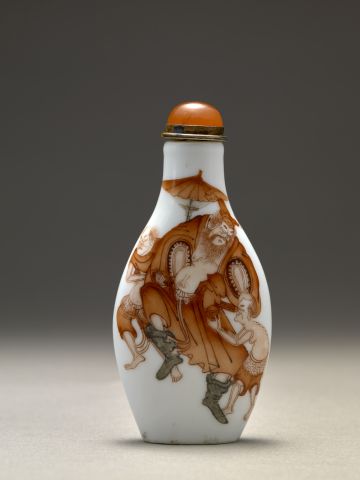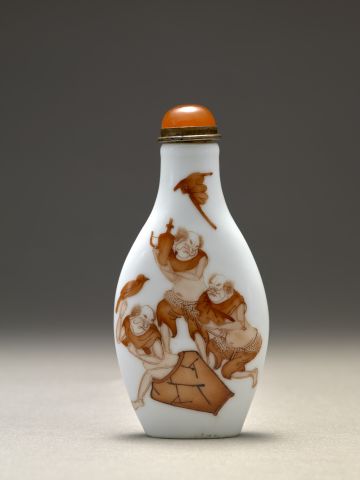

Bottle ID: 754
PORCELAIN, ZHONGGUI WITH DEMONS
Date: 1840-1900
Height: 72 mm
Porcelain, of slender teardrop form, with shoulders sloping to a long cylindrical neck, and with an indented oval foot, covered overall in a transparent glaze and decorated in iron-red and grey enamel, one main side with Zhonggui, the demon queller in loose robes and gray boots, flanked by two partially clothed demons, one holding a parasol above him, the other making an offering to him in an open box, the other main side with three partially clothed demons emerging from a large storage jar, a bat in flight above.
Similar Examples:
Crane Collection no. 251
Moss, Hugh, Victor Graham and Ka Bo Tsang, A Treasury of Chinese Snuff Bottles, The Mary and George Bloch Collection, Vol. 6, part 3, Arts of the Fire, 2008, p. 872, no. 1413
Provenance:
Mary Morrison, Vancouver, Canada
Purchased in 1981
Zhonggui, the demon queller, has been popular in Chinese mythology since the Tang Dynasty. According to slightly later sources in the Song Dynasty, the Tang Dynasty Emperor Xuanzong (AD 712-756) fell into a deep sleep while he was gravely ill, and in his fever dreamt of two ghosts. One of the ghosts stole a purse from his imperial consort, Yang Guifei, while the other larger ghost stole a flute belonging to him. The latter ghost, wearing an official's hat, captured the other ghost, tore out his eye and ate it. He then introduced himself as a demon queller by the name of Zhonggui, sworn to rid the country of evil. After the Emperor recovered from his sickness, he commissioned the court painter Wu Caozi to produce a painting of Zhonggui, the likeness of which has been faithfully copied over the centuries.
In today's households in Asia images of Zhonggui are often present to scare away ghosts and demons. In Japan, Zhonggui is known as Shoki.
< Back to full list

 English
English 中文
中文